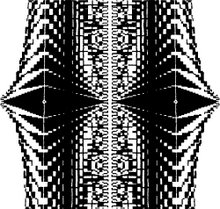
Baby mantis, Harare
This infant on a eucalyptus tree is only a few mm long, but was steady and fearless enough for me to creep up with my closeup equipment.

Sikumi: Wild dog
Quite rare, numbering a few thousand in Africa. We were already becoming quite blase about elephants (which were ahead on the road), on this our third safari, especially when this mother and her family appeared. We were seeing them for the first time, and they were happy to stay where they were, letting us get quite close.

Sikumi: Dawn buffalo herd
This was a magic moment, a gift. I could see in the early morning light of the safari that the sunlight would stream through the dust and turn these buffalo into something mysterious, identifiable only by their silhouettes, especially the horns. Once we got past them and looked back into the sun, I got what my inner vision was telling me would come - one of those happy occasions when vision and actuality line up and agree.

It's critter time on the blog!
Sikumi Park: Buffalo
Four safaris, dawn and dusk, in open vehicles, showed us most of what Zimbabwe has to offer in wildlife. I was seeing this country for the first time as an adult and a photographer, and didn't waste the opportunity. Welcome to the buffalo, Africa's meanest, most dangerous vertebrate (probably the mosquito, carrying malaria, should be called its deadliest animal overall).
 Anglican church, Nyanga
Anglican church, Nyanga
 Teak trees and cormorants, Kariba
Teak trees and cormorants, Kariba The lake was artifically created some decades ago along with a dam at one end which provides much elecrtricity to Zimbabwe. In the process, many animals had to be rescued from the flood - in Operation Naoh's Ark, as it was called - and many trees, such as these teaks, were drowned. Their wood is so hard that they remain standing after all this time, and it is still useable to make beautiful furniture or other items.
The lake was artifically created some decades ago along with a dam at one end which provides much elecrtricity to Zimbabwe. In the process, many animals had to be rescued from the flood - in Operation Naoh's Ark, as it was called - and many trees, such as these teaks, were drowned. Their wood is so hard that they remain standing after all this time, and it is still useable to make beautiful furniture or other items.
 Zimbabwe, October 2006:
Zimbabwe, October 2006:  "Other" photographic processes
"Other" photographic processes  and then develop the paper as a normal print, called a photogram. The same kind of thing can be done with the objects placed into the negative carrier of an enlarger, if they are small and thin enough, resulting in spectacular enlarged photograms. Or one can simply scan things using a regular desktop scanner. These leaves are from the scanning process, which captures fantastic detail at high resolutions. If your scanner is set at, say, 2400 dpi (dots per inch) and your printing is to be done at 300 dpi (a good resolution for photographs), the prints can be 8 times larger than the original in length and width, which can turn a leaf into a great poster child for nature lovers or the eco-minded.
and then develop the paper as a normal print, called a photogram. The same kind of thing can be done with the objects placed into the negative carrier of an enlarger, if they are small and thin enough, resulting in spectacular enlarged photograms. Or one can simply scan things using a regular desktop scanner. These leaves are from the scanning process, which captures fantastic detail at high resolutions. If your scanner is set at, say, 2400 dpi (dots per inch) and your printing is to be done at 300 dpi (a good resolution for photographs), the prints can be 8 times larger than the original in length and width, which can turn a leaf into a great poster child for nature lovers or the eco-minded. Moscow, USSR, August 19, 1991
Moscow, USSR, August 19, 1991
 Portrait of Chris A, Milborne Port, England, c. 1990
Portrait of Chris A, Milborne Port, England, c. 1990 
 Ushba, Etseri and other views from Etseri, March 2007
Ushba, Etseri and other views from Etseri, March 2007

 Frames, Etseri, February 2004
Frames, Etseri, February 2004

 Mountains across the Inguri R. from Etseri, February 2004
Mountains across the Inguri R. from Etseri, February 2004

House detail, Ushgili, December 2003
The flag of Svaneti features a lion. There was a Georgian nature magazine with a photograph of a leopard on its cover in about 2004, from the Georgian-Azeri border. Hyaenas have been reported - but not proved - in the Khevsureti region of Georgia south of Chechnya. Of wolves and bears we need not speak - they are definitely still around.

Carved door closeup, Ushguli house museum, December 2003
This magnificent work is actually for sale, for US$4000 the last I heard. Many hundreds of hours must have gone into it. Any takers?


2009-10 - A Traveling Landscape Exhibition - 4 photographs of mine in a group show: BACHMODERN Project, 24 November - 18 December 2009, Neutorstrasse 32k, 5020 Salzburg, Austria; 7-27 May 2010, Mediterranean University Campus, Antalya, Turkey: AnthonyHanmer.pdf www.bachmodern.com
2009 - Kolga.ge Book & travelling Tbilisi Exhibition, 1 entry, nominated for Best Portrait2009 - Association of Photographers (AOP) Open Exhibtion/Catalogue, 1 entry, inclusion in AOP magazine article, London, UK

Travel like a Local at Localyte.com






